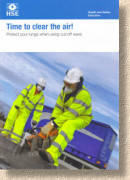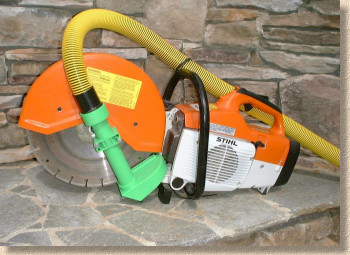Introduction:
There was a time when saws were rarely, if ever, used on site for paving projects. That time was within living memory, for the widespread use of saws really only started in the mid-to-late 1970s. Before that, most paving was cut using hand tools – an armoury of specialist plugs, splitters, chisels and hammers that would chop and trim both stone and concrete paving materials.
Saws were really only used in the quarries and mason yards to saw huge blocks of stone or scants into flags and kerbs and sundry other paving and hard-landscaping items, and they tended to be HUGE concerns, great rotating discs of teeth and straps of what seemed like scale-covered wire, typically housed in cavern-like sheds which smelled of stone dust and warm grease and well-singed carborundum. They were things of awe and wonder, machines of immense power and grandeur, man's domination over the very bedrock of the planet, shaping it to our own purpose.
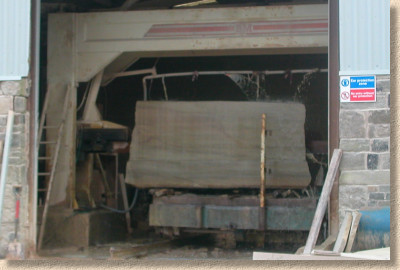
An ever-dwindling number of us were once taught how to cuts flags, kerbs, paviors, setts and cubes using non-powered tools, which is a skill which can only be acquired through repeated practice. So when hand-held powered saws came along in the early 70s, we were stunned.
Oh, to own such a tool, to wield the power to slice through those 3x2s, to mitre those hefty 6x12 kerbs, to nick the tops of edging kerbs so they'd snap neatly around a radius!
The first hand-held saw we bought, in about 1974, cost my father 150 quid second-hand, this at a time when a 60 quid pay packet was a damned good week's whack. It was a bar-steward to start – I'm sure it got through more pull-cords than blades!- and it relied exclusively on abrasive blades, which wore down at an alarming rate. You could easily get through a whole new blade trying to cut through a granite kerb or channel, such was their inefficiency.
Diamond Blades
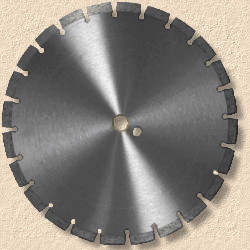
Diamond blades started to become more readily available in the early 80s, and while they wouldn't be able to hold a candle to the blades we have nowadays, the basic ability to maintain depth of cut, to have a blade that didn't shrink as it worked, was a real god-send. However, the downside was that more and more operatives began to saw all the way through a paving unit (so-called full-depth cuts) rather than the nick-to-about-25mm-depth-and-split-with-an-hammer as had been common with the unreliable abrasive blades.
To this day, I'm not sure why so many users insist on full-depth cuts when a nick-and-split would do the job just as well, with far less effort and a whole lot less dust.
And dust was always the major drawback of saw cutting. Great, billowing plumes of carcinogenic dust spewed out with gay abandon over self, site mates and the unsuspecting public. The long latency period for dust-sourced lung diseases means that we are only just beginning to reap what we sowed 40 years ago. During the work done on bringing the Clear The Air project to fruition in 2008, we uncovered data which showed that 10 construction operatives per week were dying, were dropping down dead, as a direct result of inhaling dust from site work. That's two per day, losing their lives because they spent a lifetime sucking in the dust generated by sites in general and sawing in particular.
Thankfully, we now have all sorts of ways to control the dust and to ensure today's operatives are not expected to risk their lives by cutting flags or kerbs or paviors. It's just a real shame on our industry that so few choose to heed the advice and blithely continue to use saws and grinders with no suppression and, all too often, without even a basic face mask. Stupid!
Safety at all times
Safety is paramount when using any form of saw or angle grinder. As already mentioned, dust is a significant health risk and so a suitable mask should be worn, even when dust suppression is being used. There is also a real risk from flying shards and chips spat out by the blade, so adequate eye protection in the form of goggles or safety glasses should also always be worn.

Saws tend to be noisy, so hearing protection via earplugs or muffs is also highly recommended. There is often a lot of vibration, too, so consider the risk of HAVS and whether the use of anti-vibration gloves might be warranted.
The rest of this page looks at three types of saw commonly encountered on paving installation projects (as opposed to manufacturing): Hand-held Saws , Bench-mounted Saws and Road Saws .
Hand held Saws:
In the broadest of terms, hand-held saws for paving projects can be split into two groups: the larger cut-off saws and the smaller angle grinders.
Cut-off saws are variously known as "Stihl Saws", even though there are dozens of alternative manufacturers, Still Saws and/or Skill Saws, mishearings of the previous term, Whizzers, Cutters, and dozens of other colloquial terms.
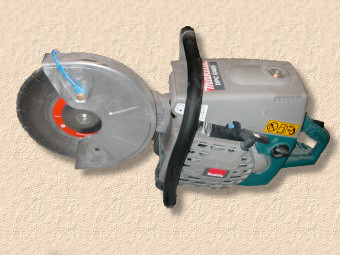
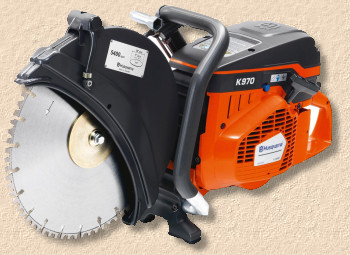
In general, they are petrol-engined, self-contained saws with a blade of around 300-400mm diameter. There are some electrically-powered versions, but the petrol-engine is, by far, the more popular option.
Angle grinders tend to be smaller, with blades of 100, 125 or 225mm diameter (although there are larger), and are most commonly powered by electricity, either 240v or 110v via a transformer. There are air-powered versions but these tend to be restricted to mechanics' workshops rather than used on site.
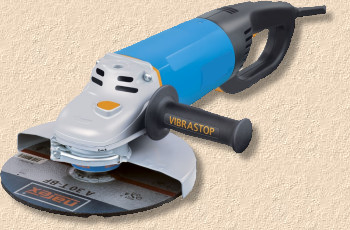
Both saws and grinders can operate with a range of blades, from general purpose site blades to specialist blades for cutting steel or porcelain tiles or clay paviors. The blades are usually held in place by a single nut mounted on the rotating spindle which makes them relatively easy to change.
Dust and hand-held cutting kit:
Hand-held saws and grinders, no matter what precise form, will churn out huge volumes of dust, which, as already mentioned, is potentially carcinogenic and, at the very least, is a significant environmental hazard. The advantage here lies with the petrol-engined saws which can be fitted with inexpensive water-spray dust suppression equipment. This enables the dust to be dampened down by a continual flow of water as the dust is generated, turning it from an air-borne menace to a liquid slurry which is much easier to control.
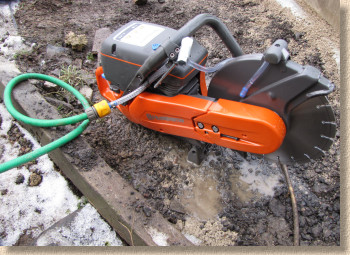
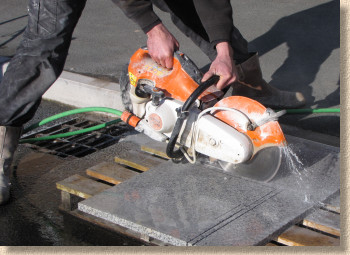
Fitting a water-based dust suppression attachment to an electrically-powered angle grinder is simply not a good idea for obvious reasons. However, there are various vacuum systems which can be fitted and used safely with angle grinders as well as with conventional cut-off saws.
Whichever form of hand-held saw is used, dust suppression is essential. To cut any paving materials or pavement surfaces without using dust suppression is daft and dangerous. Don't do it!
The dust not only causes problems for the operative, it will affect other people and animals in the locality. Further, with petrol-engines, the presence of dust in the air will compromise the performance of the engine, as air is required in the carburation system to ensure efficient running of the engine. Consequently, all such saws are fitted with an air filter which will need regular and thorough cleaning to keep the saw running at its most efficient. The exact set-up of the air filter varies from model to model, but most are very simple to access, remove, clean and then replace. Use of dust suppression will reduce the amount of cleaning required and will also extend the working life of the saw itself.
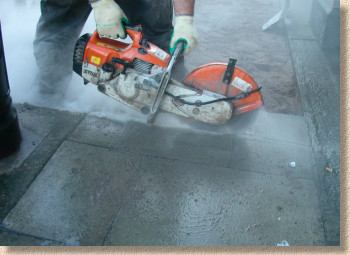
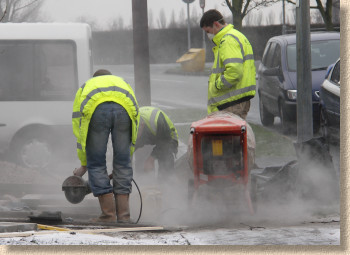
Dust also causes problems for the local environment. It will settle on surfaces which will then need to be cleaned. This is especially important on residential projects where the client is unlikely to appreciate dust covered washing lines and window sills. Again dust suppression will minimise, if not eliminate, this problem.
Cart-mounted saws
When cutting floors or pavements, there are carts available into which the hand-held saws can be mounted so that the cut can be achieved more accurately and without the need for some poor sod to be hunched over for an extended periods. Sadly, the carts tend to be make specific, rather than one-cart-fits-all, so the suitability needs to be checked before buying or hiring any particular cart.
The best carts will incorporate a water tank to feed the blade for dust suppression, and a line guide attachment to aid accurate cutting by having a sight rail extending in front of the blade where it can be seen more easily.
Cart-mounted saws can be useful when relatively shallow and short cuts (under 50m) need to be made, but their effectiveness is limited due to the size of the blade. For longer cuts, or for cuts where a depth of 75mm or more is required, a bigger Road Saw is a much better tool. These are considered below.
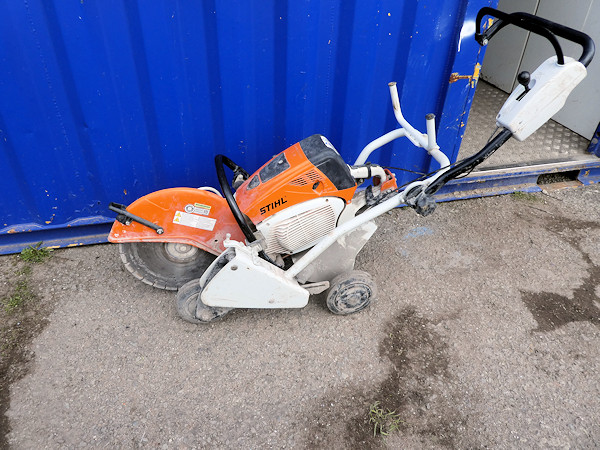
Secure Cutting

Hand-held saws and angle grinders are, potentially, extremely dangerous. If they can slice through a stone flag or concrete kerb, a finger or toe presents no challenge at all. Anecdotally, most accidents with these tools occur because the item being cut is not adequately braced or supported during the cut. All too often, we see cuts being carried out while the operative "steadies" the block or sett with their foot. Or a small paver unit is placed onto a bed of sand and cut with the hope that the fast-spinning blade won't kick it out.
The rule of thumb should be that, if there is any chance at all of the unit being moved, shunted or shifted, it should be properly braced to hold it firmly and securely in place. A large flagstone or kerb is less likely to be accidentally shifted by the saw during cutting, so they could be left unbraced, but smaller block pavers, patio flags, small unit kerbs and the like should always be braced in some way.
This might be achieved by trapping the cut unit between or beneath a much heavier item, or in some form of vice. Whatever is used, the cut unit should be secure and immovable before cutting commences. For the smaller units, such as block pavers, it really is worth considering the use of a bench saw (see below) which can hold such units securely during the cut.
Bench Saws
Bench saws are simply a saw mounted onto a specially designed table or "bench". They are commonly used by woodworkers, joiners and carpenters to cut timber, but there are versions that have been designed to cut stone, concrete and other hard paving materials.
The most regularly used type of bench saw, sometimes known as a chop saw, features a fixed blade mounted above (or sometimes beneath) the table, and works by having the cut unit forced against the rotating blade.
The blade is normally mounted on a pivoting arm above the bench. The cut unit is placed into position on the table, secured into position, and the blade brought down onto the cut unit in a sort of chopping action. The cut unit may also be moved back and forward on a sliding table.
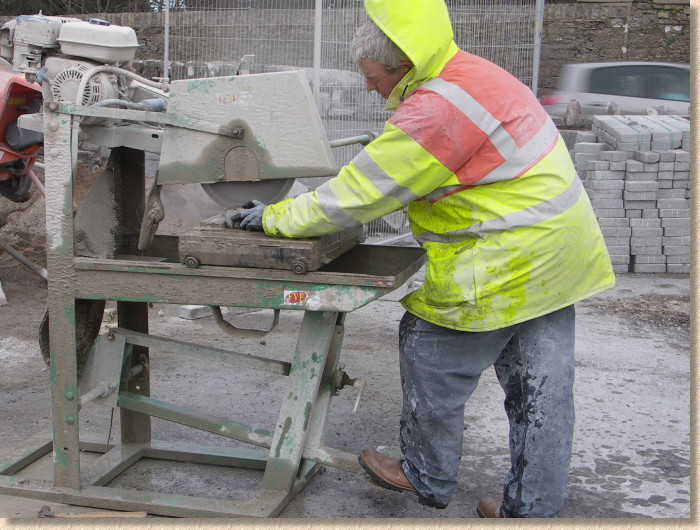
There will usually be some form of water feed onto the blade which helps with cooling but also suppresses the dust generated. Certain smaller chop saws rely on a vacuum system to suck away dust, but the efficacy is highly variable and some users complain that the vacuum motors have a short life due to aggressive abrasion from the dust. This is probably due to poor maintenance of the dust filters, but, even so, it is a point worth considering when choosing a saw.
With bench saws, the cut unit is brought to the blade, rather than the blade being taken to the cut units as is the case with hand held saws, and so the cut unit has to be capable of being lifted and placed onto the bench. This is not usually an issue with smaller paving units, but with larger items, such as kerbs or large flags, some mechanical aid may be necessary to lift the cut unit onto the bench. With the largest bench saws, such as those used to cut blocks of stone into scants, the cut unit is ferried into place using a crane or tele-handler.
With some smaller table saws, with blades mounted beneath the table, the cut unit is usually forced against the rotating blade, progressing along the cut line. In such instances, the cut unit should never, ever be pushed towards the blade by hand. A push-stick must be used to ensure the cut unit constantly presses against the blade. Much better to lose a bit of scrap timber than a finger!
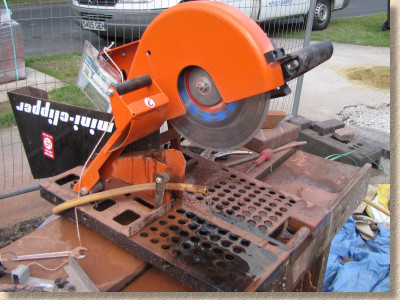
Chop saws may also require the cut unit to be moved along as cutting progresses, so, once again, a push-stick must always be used.
Bench saws (table saws, chop saws, etc.) offer some advantages over hand-held saws. When set up properly, there should be no need to bend over at an uncomfortable angle, putting pressure on the back and the hamstrings, so they are said to be ergonomically superior, reducing stress and tiredness in operatives, and a less-stressed, less tired operative is more likely to produce good quality cuts.
The real bonus, though, comes when cutting several copies of the same piece, such as mitre-cuts for corners or angled cuts for 45° block paving, because a jig can be established to accurately position each piece so that identical cuts are produced.
Road Saws
Road saws, also known as Floor Saws, are, essentially, a larger diameter blade mounted into a cart which is then pushed along a pavement surface (or floor), slicing through it to a specified depth as it progresses.
The most commonly used road saws in the paving and highways trade are manually pushed along by some poor sod that is nearly always clad from head to toe in cumbersome waterproofs to protect themselves from the splash water and slurry generated by the blade as it munches its way through the concrete or blacktop. There are larger vehicle mounted versions for bigger jobs.
The typical road saw will have a blade with a diameter of 450-900mm, depending on just how large a job is being undertaken. Bigger blades enable deeper cuts and faster cutting.
The height of the blade is adjustable - it starts off just above the pavement surface and is lowered as the blade cuts into the substrate until the depth of cut is as required, and then the cart is pushed forward. Once a cut is completed, the blade is raised out of the cut slit to a height above the pavement surface, and then moved away to the next location.
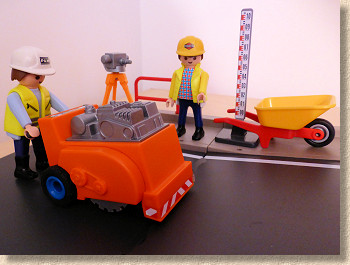
The cart will nearly always incorporate a water tank to constantly feed the blade and suppress any dust. Some models will have a hose attachment which feeds through to a float switch keeping the reservoir tank at a workable level. Dry cutting is dangerous as many shards can be ejected as the blade spins, not to mention the huge clouds of potentially carcinogenic dust and the reduced service life of a blade that has been allowed to overheat.
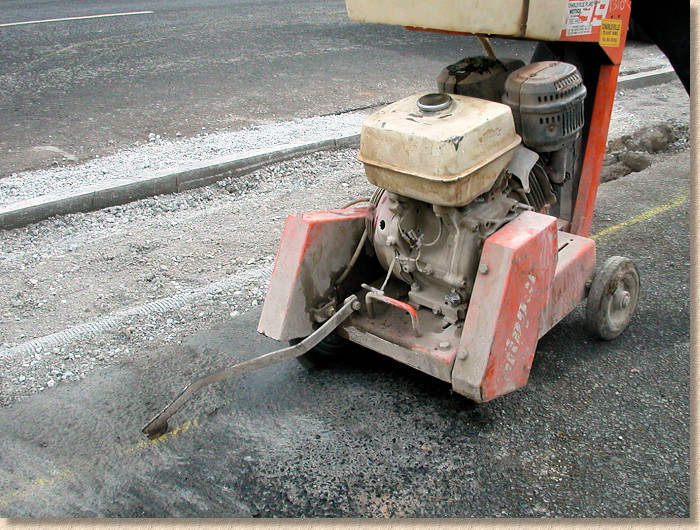
Road saws are not really used to cut individual paving elements, but to slice through or trim existing surfaces. They might be used to trim the edge of a block pavement to accommodate an edge course, but they would not be used to cut individual blocks. They are commonly used to cut through monolithic surfaces such as concrete or asphalt when a patch is necessary, or access to sub-service utilities is required. They are also used to trim the free edge of a blacktop screed when a multiple-pass carriageway is being laid.

